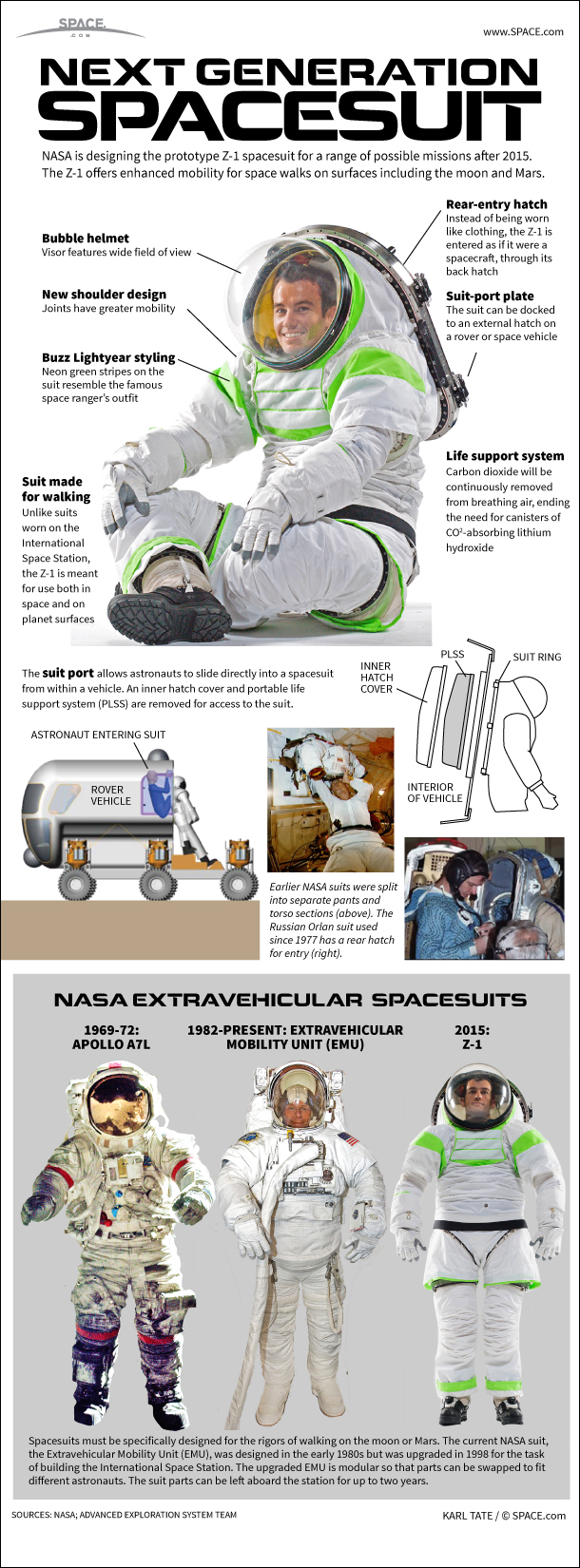Introducing NASA'S Future Spacesuit, the Z-1 (Infographic)

NASA is designing the prototype Z-1 spacesuit for a range of possible missions after 2015. The Z-1 offers enhanced mobility for space walks on the moon and Mars.
A major innovation in the Z-1 is its rear-entry hatch. Instead of being worn like clothing, the Z-1 is entered as if it were a spacecraft, through its back hatch.
Through a back-mounted suit-port plate, the suit can be docked to an external hatch on a rover or space vehicle. The suit port arrangement allows astronauts to slide directly into a spacesuit from within a vehicle. An inner hatch cover and portable life support system (PLSS) are removed for access to the suit.
Earlier NASA suits were split into separate pants and torso sections. The Russian Orlan suit used since 1977 has a rear hatch for entry, similar to the Z-1 design.
Another innovation in the Z-1 is its life-support system. Carbon dioxide will be continuously removed from breathing air, ending the need for canisters of CO2-absorbing lithium hydroxide.
The Z-1's bubble helmet features a wide field of view. Newly-designed shoulder joints have greater mobility.
The Z-1 prototype's neon green stripes resemble space ranger Buzz Lightyear's outfit.
Unlike suits worn on the International Space Station, the Z-1 is meant for use both in space and on planet surfaces. Spacesuits must be specifically designed for the rigors of walking on the moon or Mars.
The current NASA suit, the Extravehicular Mobility Unit (EMU), was designed in the early 1980s but was upgraded in 1998 for the task of building the International Space Station. The upgraded EMU is modular so that parts can be swapped to fit different astronauts. The suit parts can be left aboard the station for up to two years.
Join our Space Forums to keep talking space on the latest missions, night sky and more! And if you have a news tip, correction or comment, let us know at: community@space.com.
Get the Space.com Newsletter
Breaking space news, the latest updates on rocket launches, skywatching events and more!

Karl's association with Space.com goes back to 2000, when he was hired to produce interactive Flash graphics. From 2010 to 2016, Karl worked as an infographics specialist across all editorial properties of Purch (formerly known as TechMediaNetwork). Before joining Space.com, Karl spent 11 years at the New York headquarters of The Associated Press, creating news graphics for use around the world in newspapers and on the web. He has a degree in graphic design from Louisiana State University and now works as a freelance graphic designer in New York City.
